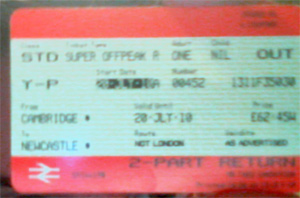Team:Cambridge/Notebook/Week2
From 2010.igem.org
(Difference between revisions)
EmilyKnott (Talk | contribs) |
EmilyKnott (Talk | contribs) |
||
| Line 6: | Line 6: | ||
== Monday== | == Monday== | ||
| + | In the morning we did further research into the enzymes required for luciferase recovery and found that | ||
| + | |||
Did further research into the enzymes required for luciferase recovery. | Did further research into the enzymes required for luciferase recovery. | ||
* Presented proposals to advisors | * Presented proposals to advisors | ||
Revision as of 10:47, 9 August 2010

Notebook: Week 2
Week 1: Monday 19th - Sunday 25th July
Monday
In the morning we did further research into the enzymes required for luciferase recovery and found that
Did further research into the enzymes required for luciferase recovery.
- Presented proposals to advisors
- Modelled RNA to create aptazyme based system using trial of CLC RNA Workbench
- Made presentation for Newcastle
- Set up and tested low light camera
Tuesday
- 06.50 - Train to Newcastle for UK iGEM get-togther
Wednesday
Thursday
- 11am - Health and Safety talk by Barbara
- Working lunch at the Waffle Company. Summary of discussion:
- To do:
- Ordering
- Getting in touch with MIT (turning off lights)
- T-Shirts
- Project Plan (Gantt Chart etc)
- To do long-term:
- Modelling
- Firefly Bioluminescence
- Bacterial Bioluminescence
- Human Practices
- Quiescence
- Individual roles:
- Outline of experiments, protocols - Anja, Ben, Peter (especially controls)
- Modelling - Paul, Bill, Emily
- COSHH forms - Bill
- LRE biobrick - Theo
- Researching Bacterial Lux operon - Will, Hannah
- To do:
Friday
Meeting with Laura Rowe in the Biotechnology Dept. at 3pm:
- Brightness measurements are integrated over time, so when comparing them make sure they are integrated over a long time (otherwise you are only measuring how quickly luminescence occurs, not how bright).
- Different colours:
- Could use fluorophores instead of fluorescent proteins but need to ensure they attach to protein (could be a project in itself). Requires resonance energy transfer.
- Using mutant luciferases probably easier to implement.
- Expression in E. coli: inclusion bodies could be a problem when trying to over-express genes. To test: break open cells and centrifuge twice (at a higher speed second time around), if pellets are formed these are probably inclusion bodies. Could then dissolve these with solvent and test for bioluminescence from proteins within inclusion bodies.
- Relative light units are used because different camera properties, distances etc. all mean that photons/sec are relative. Can use a source for calibration - tritium standards are used (e.g. MGM instruments).
Paper from Duncan about mutant bacterial strain with very bright luminescence to be investigated further.
Saturday
Sunday
 "
"
